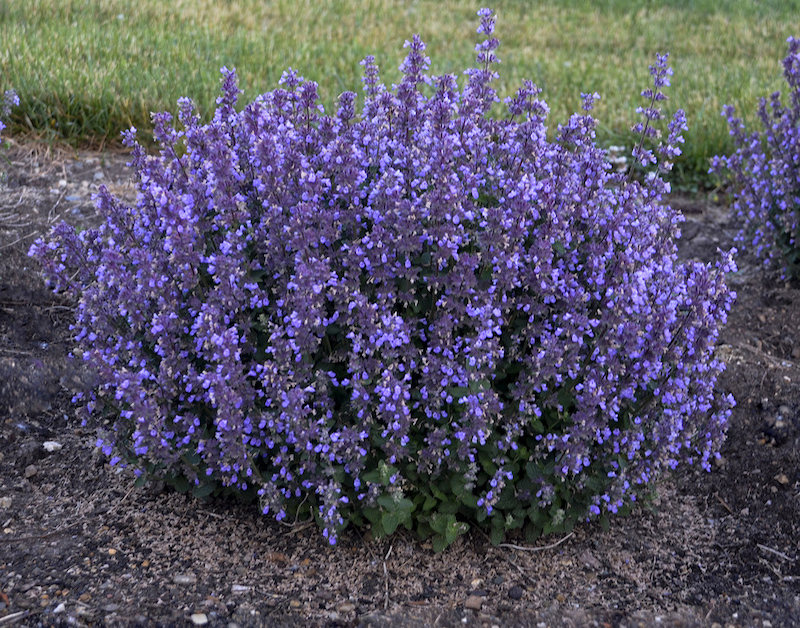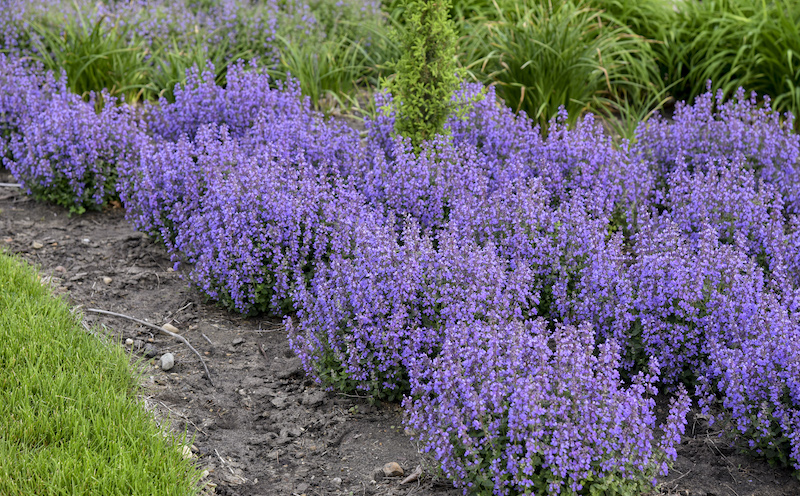Catmint is part of the mint family and is a very easy to grow perennial that is a great substitute for Lavender in colder regions of the United States. The scientific name is Nepeta x faassenii and is often confused with its cousin, Nepeta cataria, common catnip. Catmint likes to have a spot in full sun, but will tolerate shade early or late in the day. Planting Catmint is easy and fun, and with a few extra steps this perennial will be long lasting in your garden.

What You Need To Plant Catmint
- Shovel or transplanting spade
- Hand pruners
- Organic compost or finely shredded bark for mulch
- Site with full sun and well draining soil
- Watering can or hose
Where to Plant Catmint
The best spot to plant Catmint is in full sun, with at least 6 hours of direct light. Shading early in the morning or late in the afternoon is acceptable. The soil needs to be free draining with a loamy or sandy texture. Heavy clay soil will hold too much moisture, especially over the winter months. The spot also should have a good depth of soil so that the roots can grow down and outward. Shallow soils around the bases of trees will prevent proper root spread for Catmint.
Catmint Spacing
Catmint has over 250 varieties that range in size from 10 inches tall to over 4 feet tall. Plants need to be placed far enough apart to promote good air circulation but also close enough to be aesthetically pleasing. The mature height and width will be listed on the plant tag included from the nursery. Use the mature width as the distance between plants, measuring from the center of one plant to the center of the next plant. As an example, the variety ‘Walker’s Low’ has a spread of 3 feet.
The plants need to be planted 3 feet apart between centers, roughly 18 inches between each plant. Catmint does not have invasive roots like other members of the Mint family, but it does grow vigorously. Growing Catmint near a foundation or driveway is perfectly fine. The roots will not cause any damage. Depending on the overall height of Catmint that you choose, supportive hoops or canes may help to keep the plant from being top heavy while in full bloom.

Steps To Plant Catmint
Step 1 - Dig a hole that is as deep and twice as wide as the pot your Catmint was grown in.
Step 2 - Gently take the plant out of the pot and tease the roots gently from the root ball to help the roots to grow outward.
Step 3 - Place the rootbal in the hole and firm the soil back around the plant making sure to fill up any large air pockets with soil.
Step 4 - Do not plant Catmint too deep. The crown should not be covered and should sit just at or slightly above soil level.
Step 5 - Water in the plant well letting the water soak in completely and then give it another drink.
Step 6 - After all of the water has soaked in, mulch the base of the plant with 2-3 inches of organic material.
Step 7 - Prune off any branches that have been damaged in the planting process. New growth will happen quickly.
When to Plant Catmint
Catmint is perennial that can be planted almost any time of the year, depending on your hardiness zone. Early spring is typically the best time. A fall planting, just before it goes dormant for the winter, will work well in the warmer hardiness zones. Consistent watering is the most crucial factor in getting Catmint to establish well. Longer watering sessions that penetrate deeply in the soil are much more beneficial than watering for shorter periods, more often. All perennials appreciate being planted either early in the day or on an overcast day. This will lessen the amount of transplant shock that the plant will go through.
Transplanting Catmint
Nepeta is easily divided after 3-4 years. Dividing the plants will promote vigorous growth and prolific blooming. Catmint plants grow in expanding clumps that can be dug up and split down the middle. Divided plants need to be replanted as quickly as possible and kept well watered until new growth appears. Taking cuttings of Catmint early in the spring before flower buds form is also a great way to propagate it. Cut a piece of stem a couple inches long without any flower buds. Place cuttings around the sides of a pot with well-draining potting soil. Keep the cuttings fairly humid and consistently moist.
The roots of Catmint are quite fibrous and can spread out extensively from the plant. When digging up one of these plants, make sure to get as much of the root ball as possible to support the top growth. Before planting a division, the top growth can be cut back by half. This will allow Catmint to focus its energy on establishing sturdy roots without having to support extra top growth at the same time. Do not be afraid to move a Catmint that is not doing well or is planted in the wrong site. They tolerate transplanting easily.
 |
Author Robbin Small - Published 7-14-2022 |
